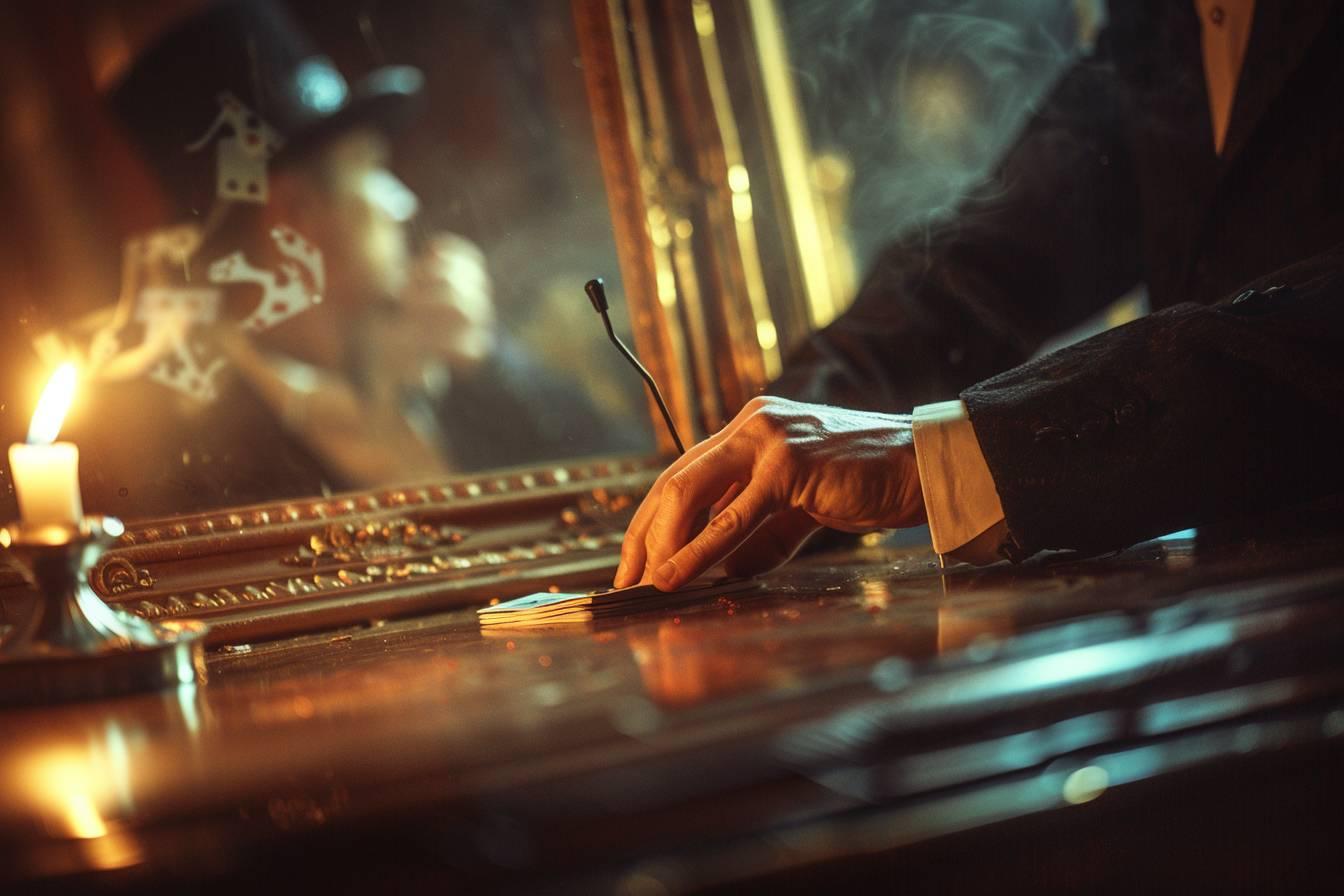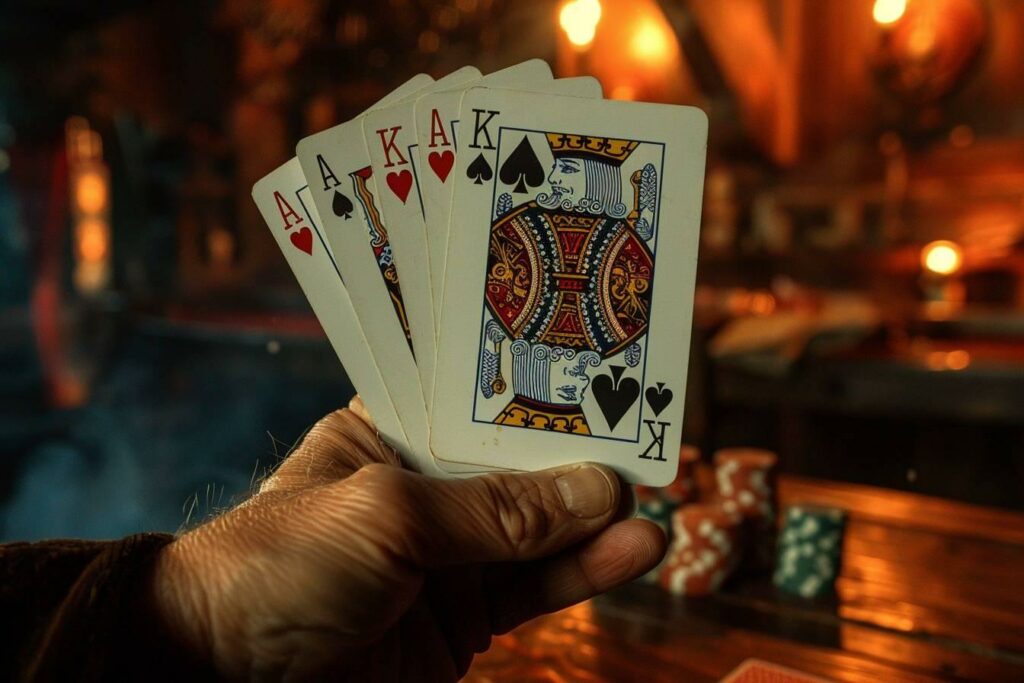The 21-card magic trick is a mentalism classic that has fascinated audiences for generations. Also known as“21-card divination“, the trick subtly combines mathematics and psychology to create the illusion of mind reading. Popularized by magicians such as Harry Houdini and David Copperfield, it continues to amaze 21st-century audiences. Let’s discover the secrets of this amazing trick and learn how to perform it like a pro.
The principles of the 21-card magic trick
The 21-card trick is based on a clever mathematical principle. It uses base 3 to locate the spectator’s chosen card. Here are the key elements to understand:
- Use of 21 cards from a standard deck
- 3 columns of 7 cards each
- Repeat the process 3 times
- Locating the card by logical deduction
The strength of this trick lies in its apparent simplicity. The magician appears to be simply redistributing the cards, when in fact he is methodically sorting them. This method gradually narrows down the field of possibilities until the chosen card is isolated.
The psychological aspect also plays a crucial role. The magician must maintain the spectator’s attention while concealing the mechanics of the trick. It’s this blend of technique and showmanship that makes the 21-card trick so magical.
Step-by-step mentalism trick
To perform this easy mentalism trick, follow these step-by-step instructions:
- Take 21 cards from a standard deck and spread them out face-up in front of the spectator.
- Ask the spectator to mentally select a card without touching it.
- Collect the cards and distribute them in 3 columns of 7 cards, face up.
- Ask the spectator which column his card is in.
- Collect the columns, placing the one containing the chosen card in the middle.
- Repeat steps 3-5 two more times.
- After the third deal, the chosen card will always be the 11th in the pack.
The key to success is smooth execution. Practice this trick in front of a mirror to fine-tune your gestures and presentation. Don’t hesitate to add your own personal touch, such as a touch of humor or an element of staging, to make the experience more memorable.
| Step | Magician’s action | Spectator’s reaction |
|---|---|---|
| 1 | Presentation of 21 cards | Observation |
| 2 | Request for mental selection | Choice of card |
| 3-5 | Distribution and collection (x3) | Indication of column |
| 6 | Reveal card | Surprise and wonder |

Tips for perfecting your performance
To take your 21-card magic trick to the next level, here are a few tips from the pros:
Misdirection: Use distraction techniques to draw the spectator’s attention away from the crucial manipulations. For example, engage in lively conversation while you’re dealing the cards. This technique, used by illusionists like Derren Brown, adds a layer of mystery to your performance.
Storytelling: Create a story around the trick. You could, for example, pretend to use an ancient method of divination learned on a trip to Egypt. This adds depth and interest to your performance.
False shuffles: Learn how to make shuffles that appear random but preserve the order of the cards. This technique, popularized by magicians like Dai Vernon, reinforces the illusion of impossibility.
Varying the number of cards: Once you’ve mastered the classic trick, try variations with 27 or 15 cards. This will enable you to adapt the trick to different situations and surprise even those who know the standard version.
By incorporating these tricks, you’ll turn a simple card trick into a true mentalism experience. Remember, practice makes perfect. As the famous magician Harry Blackstone Sr. said,“Magic is the art of deceiving the eye and the mind“. The more you refine your technique, the more convincing the illusion will be.
The impact of the 21-card trick on the history of magic
The 21-card magic trick has left an indelible mark on the history of illusionism. Its influence extends far beyond simple parlour entertainment:
Historical evolution: This trick, whose origins date back to the 18th century, has been perfected over the generations. Magicians such as Jean Eugène Robert-Houdin incorporated it into their shows, contributing to its popularization. In the 20th century, innovators like Juan Tamariz developed sophisticated variations, demonstrating the versatility of this mathematical principle.
Cultural impact: The 21-card trick has transcended the world of magic to infiltrate popular culture. It can be found in detective novels, films and even video games, where it often symbolizes cunning and intelligence. This omnipresence testifies to its evocative power and its ability to fascinate beyond the circle of the initiated.
Learning and teaching: This trick is frequently used as an educational tool to teach basic mathematical concepts. It illustrates principles of logic and probability in a playful way, making these notions more accessible and attractive to students. Teachers all over the world use it to stimulate interest in mathematics.
By mastering this easy mentalism trick, you’re not just learning something fun. You’re part of a long tradition of magic, perpetuating an art that continues to fascinate and inspire. As the great Houdini so aptly put it:“Magic is the only science not recognized by man“. By performing this trick, you become the guardian of a secret that has spanned the centuries, ready to amaze a new generation of spectators.

